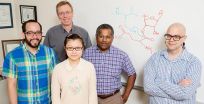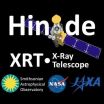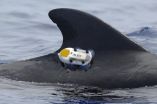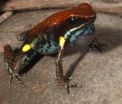(Press-News.org) Why do we remember some things and not others? In a unique imaging study, two Northwestern University researchers have discovered how neurons in the brain might allow some experiences to be remembered while others are forgotten. It turns out, if you want to remember something about your environment, you better involve your dendrites.
Using a high-resolution, one-of-a-kind microscope, Daniel A. Dombeck and Mark E. J. Sheffield peered into the brain of a living animal and saw exactly what was happening in individual neurons called place cells as the animal navigated a virtual reality maze.
The scientists found that, contrary to current thought, the activity of a neuron's cell body and its dendrites can be different. They observed that when cell bodies were activated but the dendrites were not activated during an animal's experience, a lasting memory of that experience was not formed by the neurons. This suggests that the cell body seems to represent ongoing experience, while dendrites, the treelike branches of a neuron, help to store that experience as a memory.
"There are a lot of theories on memory but very little data as to how individual neurons actually store information in a behaving animal," said Dombeck, assistant professor of neurobiology in the Weinberg College of Arts and Sciences and the study's senior author. "Now we have uncovered signals in dendrites that we think are very important for learning and memory. Our findings could explain why some experiences are remembered and others are forgotten."
In the brain's hippocampus, there are hundreds of thousands of place cells -- neurons essential to the brain's GPS system. Dombeck and Sheffield are the first to image the activity of individual dendrites in place cells.
Their findings contribute to our understanding of how the brain represents the world around it and also point to dendrites as a new potential target for therapeutics to combat memory deficits and debilitating diseases, such as Alzheimer's disease (AD). Disruption to the brain's GPS system is one of the first symptoms of AD, with many patients unable to find their way home. Understanding how place cells and their dendrites store these types of memories could help us find new ways to treat the disease.
The Northwestern study will be published Oct. 26 by the journal Nature.
Neuroscientist John O'Keefe discovered place cells in 1971 (and received this year's Nobel Prize in physiology and medicine), but it is only in the last few years that scientists, such as Dombeck and Sheffield, have been able to image these neurons that represent a map of where we are in our environment.
In their study, Dombeck and Sheffield found dendrite signals that could explain how an animal can experience something without storing the experience as a memory.
They saw that dendrites are not always activated when the cell body is activated in a neuron. Signals produced in the dendrites (used to store information) and signals within the neuron cell body (used to compute and transmit information) can be either highly synchronized or desynchronized depending on how well the neurons remember different features of the maze.
Scientists have long believed that the neuronal tasks of computing and storing information are connected -- when neurons compute information, they are also storing it, and vice versa. The Northwestern study provides evidence against this classic view of neuronal function.
"We experience events all the time, which must be represented in the brain by the activity of neurons, but not all these events can be recalled later," said Mark E. J. Sheffield, a postdoctoral fellow in Dombeck's lab and first author of the study.
"A daily commute to work, for example, requires the activity of millions of neurons, but you would be hard pressed to remember what was happening halfway through your commute last Tuesday," Sheffield said. "How is it then that the neurons could be activated during the commute without storing that information in the brain? Now we may have an explanation for how this occurs."
Dombeck and Sheffield built their own laser scanning microscope that can image neurons on multiple planes. They then studied individual animals navigating (on a trackball) a virtual reality maze constructed using the video game Quake II.
Each lit-up structure seen in the images they took indicate a neuron firing action potentials. The activity of these neurons represents an animal's experience of where it is in the environment, the researchers said. Whether the neurons store this experience or not appears to depend on the activity of the neurons' dendrites.
INFORMATION:
The title of the Nature paper is "Calcium transient prevalence across the dendritic arbor predicts place field properties."
Digoxin, a medication used in the treatment of heart failure, may be adaptable for the treatment of amyotrophic lateral sclerosis (ALS), a progressive, paralyzing disease, suggests new research at Washington University School of Medicine in St. Louis.
ALS, also known as Lou Gehrig's disease, destroys the nerve cells that control muscles. This leads to loss of mobility, difficulty breathing and swallowing and eventually death. Riluzole, the sole medication approved to treat the disease, has only marginal benefits in patients.
But in a new study conducted in cell cultures ...
CHAMPAIGN, Ill. — Researchers report in the journal Nature that they have made a breakthrough in understanding how a powerful antibiotic agent is made in nature. Their discovery solves a decades-old mystery, and opens up new avenues of research into thousands of similar molecules, many of which are likely to be medically useful.
The team focused on a class of compounds that includes dozens with antibiotic properties. The most famous of these is nisin, a natural product in milk that can be synthesized in the lab and is added to foods as a preservative. Nisin has ...
Most of the concerns about climate change have focused on the amount of greenhouse gases that have been released into the atmosphere.
But in a new study published in Science, a group of Rutgers researchers have found that circulation of the ocean plays an equally important role in regulating the earth's climate.
In their study, the researchers say the major cooling of Earth and continental ice build-up in the Northern Hemisphere 2.7 million years ago coincided with a shift in the circulation of the ocean – which pulls in heat and carbon dioxide in the Atlantic ...
DENVER – A better survival outcome is associated with low blood levels of squamous cell carcinoma antigen, or absence of tumor invasion either into the space between the lungs and chest wall or into blood vessels of individuals with a peripheral squamous cell carcinoma, a type of non-small cell lung cancer (NSCLC).
Lung cancer is the most common cause of cancer-related death worldwide and lung squamous cell carcinomas (SCC) account for 20-30% of all NSCLC. SCC can be classified as either central (c-SCC) or peripheral (p-SCC) depending on the primary location. While ...
VIDEO:
On Oct. 23, while North America was witnessing a partial eclipse of the sun, the Hinode spacecraft observed a 'ring of fire' or annular eclipse from its location hundreds of...
Click here for more information.
The moon passed between the Earth and the sun on Thursday, Oct. 23. While avid stargazers in North America looked up to watch the spectacle, the best vantage point was several hundred miles above the North Pole.
The Hinode spacecraft was in the right place at the ...
DURHAM, N.C. -- Many marine animals are world travelers, and scientists who study and track them can rarely predict through which nations' territorial waters their paths will lead.
In a new paper in the journal Marine Policy, Duke University Marine Lab researchers argue that coastal nations along these migratory routes do not have precedent under the law of the sea to require scientists to seek advance permission to remotely track tagged animals in territorial waters.
Requiring scientists to gain advance consent to track these animals' unpredictable movements is impossible, ...
DURHAM, N.C. – Frogs are well-known for being among the loudest amphibians, but new research indicates that the development of this trait followed another: bright coloration. Scientists have found that the telltale colors of some poisonous frog species established them as an unappetizing option for would-be predators before the frogs evolved their elaborate songs. As a result, these initial warning signals allowed different species to diversify their calls over time.
Zoologists at the National Evolutionary Synthesis Center (NESCent), the University of British Columbia, ...
NASA scientists have identified an unexpected high-altitude methane ice cloud on Saturn's moon Titan that is similar to exotic clouds found far above Earth's poles.
This lofty cloud, imaged by NASA's Cassini spacecraft, was part of the winter cap of condensation over Titan's north pole. Now, eight years after spotting this mysterious bit of atmospheric fluff, researchers have determined that it contains methane ice, which produces a much denser cloud than the ethane ice previously identified there.
"The idea that methane clouds could form this high on Titan is completely ...
In a study just published in the International Journal of Cardiology, researchers from the K.G. Jebsen Center for Exercise in Medicine – Cardiac Exercise Research Group (CERG) at the Norwegian University of Science and Technology (NTNU) and the Department of Cardiothoracic Surgery at the St. Olavs Hospital in Trondheim, Norway have shown that shutting off the blood supply to an arm or leg before cardiac surgery protects the heart during the operation.
The research group wanted to see how the muscle of the left chamber of the heart was affected by a technique, called ...
Endurance athletes taking part in triathlons are at risk of the potentially life-threatening condition of swimming-induced pulmonary oedema. Cardiologists from Musgrove Park Hospital, Taunton, writing in the Journal of the Royal Society of Medicine, say the condition, which causes an excess collection of watery fluid in the lungs, is likely to become more common with the increase in participation in endurance sports. Increasing numbers of cases are being reported in community triathletes and army trainees. Episodes are more likely to occur in highly fit individuals undertaking ...






